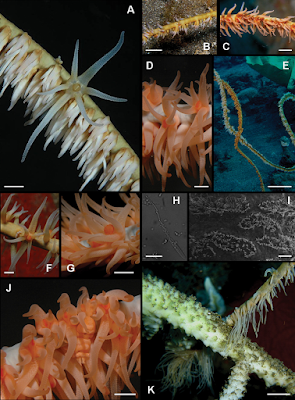 |
| Pseudocirrhipathes mapia
Bo & Bavestrello, 2009
|
Abstract
The new species, Pseudocirrhipathes mapia, is herein described from specimens coming from the coral reefs of the Bunaken Marine Park (North Sulawesi, Indonesia). The species is characterized by an unbranched thin corallum up to 1 m high (maximum basal thickness 4 mm), with large polyps arranged irregularly on one side of the stem, and by tentacles that are not completely contractile. The skeleton shows an array of spine morphologies along the stem, although most are typically verticillated in the apical section and highly tuberculated in the central portion. The study of its cnidome revealed the presence of an extremely long basitrich isorhiza. The morphological analysis has been coupled with a molecular study of the rDNA ITS sequences confirming the existence of the new genus Pseudocirrhipathes and its inclusion, together with the genus Allopathes, in a separate clade related to the Antipathidae.
Keywords: New species, ITS rDNA, basitrich isorhiza, morphology, Indonesia
Genus Pseudocirrhipathes Bo and Bavestrello n. gen.
Pseudocirrhipathes mapia Bo and Bavestrello n. spec.
Cirripathes? sp. Thomson and Simpson, 1905
Cirripathes rumphii van Pesch, 1910 (pro parte)
Eucirripathes rumphii van Pesch, 1914 (pro parte)
Diagnosis: Monopodial corallum, not ramified nor pinnulated, straight or slightly coiled in the distal portion. The stem of the colony is thin, flexible and characterized by a very large hollow central canal, especially in the apical portion. Spines triangular or sub-triangular, mainly perpendicular to the axis, with numerous rounded tubercles at least in a portion of the stem; arranged in verticils at the apex of the colony. Polyps large, 1–4 mm in transverse diameter, with long sagittal tentacles (up to 7 mm), not completely contractile, with 10 mesenteries; arranged in irregular rows along the stem, and leaving free most of the abpolypar side. Typical large isorhizae are present.
 |
Figure 4 Underwater photographs of Pseudocirrhipathes mapia.
A, macro‐photograph of P. mapia showing an expanded polyp surrounded by resting zooids that do not completely contract their tentacles; B, abpolypar side of a P. mapia colony showing the polyp‐free side of the axis; C, polypar side of a P. mapia colony; D, macro‐photograph of P. mapia showing expanded polyps. Sagittal tentacles are inserted at a lower level; E, two colonies of P. mapia; F, expanded polyp of P. mapia showing the double margin mouth; G, open mouth of an egesting polyp; H, a large discharged basitrich isorhiza, showing the spiny stylet and the incompletely extruded filament; I, patch distribution of nematocysts on the ectodermal surface of the tentacle; J, colony of P. mapia hiding a mimicking Pontonides unciger; K, extremely long sweeper tentacles of a white P. mapia, touching a dead Acropora. Images A, D, F, G, J are courtesy of Massimo Boyer.
Scale bars: H, 25 µm. G, I, 1 mm. A, D, F, J, 2 mm. B, C, 5 mm. K, 20 mm. E, 20 cm. DOI: 10.1080/11250000802684104
|
Remarks: Pseudocirrhipathes is the third genus of black coral, together with Cirrhipathes and Stichopathes, characterized by a monopodial, unbranched and unpinnulated corallum. It differs from Stichopathes by having irregularly arranged polyps and from Cirrhipathes by having tuberculated verticillated spines and, as observed in situ, tentacles unable to completely contract (Figure 2). The genus Allopathes is always distinguishable due to the shape of the colonies, which are composed of several elongated stems arising from a short trunk-like base or primary stem (Opresko 2003).
Etymology: The generic name is derived from the words ‘‘pseudo’’ (false) and ‘‘cirrhipathes’’ in reference to the apparent similarity of this genus to Cirrhipathes. [Note: The original genus name Cirrhipathes was later cited as Cirripathes; however, this is considered an incorrect emendation (see Opresko & Cairns 1994).] The specific name refers to the Indonesian term ‘‘mapia’’ meaning ‘‘beautiful’’. Mapia is also the name of the dive site where it was collected for the first time and where the population shows its highest density.
Distribution: Indonesian Archipelago (Bunaken Marine Park, Ambon, Bali, Timor, Flores), Ceylon.
M. Bo , M. Barucca , M. A. Biscotti , A. Canapa , H. F. N. Lapian , E. Olmo and G. Bavestrello. 2009. Description of Pseudocirrhipathes (Cnidaria: Anthozoa: Hexacorallia: Antipathidae), A New Genus of whip black corals from the Indo‐Pacific. Italian Journal of Zoology. 76(4); 392-402. DOI: 10.1080/11250000802684104